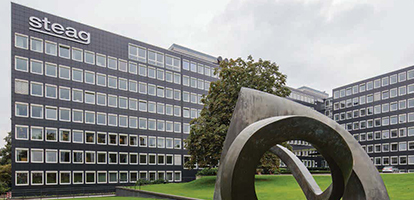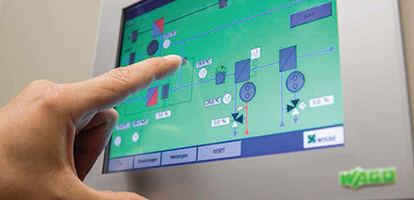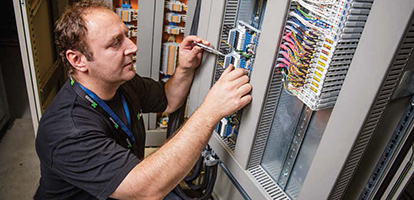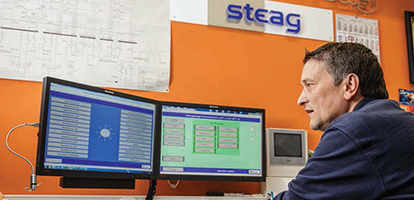




The building services provider, Wisag, replaced an old, proprietary building automation system in the Steag control center with a modern one that is not tied to a specific manufacturer. The new system uses I/O controllers from WAGO as key elements. It integrates multiple, previously decentralized technical islands and substantially facilitates building management.
If you had asked Rüdiger Lempka a few months ago what his job entailed, he would have probably responded, “Jogging”. Lempka is Manager for Building Maintenance at Steag GmbH in Essen. The fifth-largest energy producer in Germany resides in a building complex from the 50’s, which has eight floors, corridors that extend more than 90 meters, and is protected as an example of historic architecture. At the beginning of the 90’s, Steag took over the building and had the interior completely renovated. Within this context, Steag added a tiny bit of intelligence based on building automation to the numerous technical systems, like heating and cooling systems, the elevators, and the freezers in the cafeteria.
As the years passed, this minimal intelligence left a lot to be desired. “The existing building controls required increasingly more maintenance. They had not fulfilled our functional needs for a long time,” explains Lempka. In addition, various modernizations over the course of two decades had created numerous technical islands that could no longer communicate with the existing I&C system. Instead, they used proprietary communication standards depending on the different manufacturers. “This created an enormous expense for us, just to ensure that everything worked properly,” states Lempka.
Simplifying Controls and Maintenance
The extensive maintenance rounds that Lempka had to complete are now another historical footnote. Within 18 months, Wisag brought the entire building control system within the Steag headquarters up to a modern level.
Lempka explains the selection of the building services provider that Steag chose for the project thusly: “Wisag has cared for our building for a long time; however, only indirectly with regard to the building control system’s manufacturer. Within the context of the modernization project, we wanted to involve Wisag directly as a partner, and, above all, replace the old building control system with an open-source one.” This was supposed to simplify the building manager’s job — at least that was their hope — particularly in relation to control and maintenance. To achieve this, the technology islands needed to be integrated. The other requirement was to handle failures better than previously. “The old system sent error messages through a server to a printer in the security station. The security employees then had to call the respective building management colleague on the telephone and read the error message to him in order to pass on the information,” explains Peter Grüner, Building Management technician. This procedure was complicated and did not solve anything in a timely fashion.
The external requirements for the project were also challenging. The old building control system had to be replaced as quietly as possible. No new cables could be laid, and the ceilings and walls could not be touched. “We took two months to develop a plan for optimally implementing these requirements,” states the project manager from Wisag. “We brought our own requirement to the job: the new control system would not be an ungainly patchwork of old and new technologies.”
Reducing Installation Costs on Site
It was necessary to integrate a dozen controllers into nine control cabinets within the building. Wisag examined each one carefully before coming up with their successful idea; they would not merely switch out the old components with new, but instead completely pre-install the new technology on the insides of the control cabinet doors.
It was clear from the beginning that Wisag planned to base the new building automation systems on WAGO controllers. “I can’t think of a more suitable product for integrating different technological islands and for efficiently configuring the entire building management system,” states Wisag’s project manager. “Another point in favor of the WAGO solution is the unbeatable cost-benefit ratio.” However, it was the manner in which the WAGO controllers and components are installed that placed these components at the front of the queue when selecting the technology. The Wisag team manufactured the new control cabinet doors in a low volume production run, installed the new technology on them, and programmed the WAGO controllers. This meant that on site, it was simply a matter of removing the old cabinet doors, hanging the new, wiring the components, and calibrating the programmed settings. Each control cabinet was then equipped with a touch screen for locally monitoring and controlling the systems.
This process resulted in an impressive installation, and was also extremely economical. The project manager explains, “By pre-assembling the control cabinet doors in series production, we more than made up for the time necessary for planning.” In addition, this method was immensely helpful in avoiding errors during wiring.
Troubleshooting from Anywhere
One part of the wiring demanded a lot of thought in order to find a solution: the existing building automation only used a serial data connection. Since laying new cables was undesirable, the Wisag team, in collaboration with the IT department from Steag, made a virtue of necessity: they were able to provide ETHERNET-capable serial connections using select adapters. The WAGO controllers now transmit their information from the control stations using Modbus TCP/IP. The end result is that Lempka and Grüner can access the entire technical building systems using a conventional web browser. “We can control every technical system from our PC workstations,” gloats Peter Grüner.
While error messages are still routed first to the security station, a BACnet/ IP Controller from WAGO serves as a gateway that now transmits the messages to a computer monitor in the station. Since the entire system is now web-based, an additional refinement was now technologically possible: the system now automatically sends all error messages as email to the smartphones of the on-call maintenance staff. This allows Lempka and Grüner to troubleshoot problems from home — simply by using a secure data line. The Wisag team was delighted by the successful collaboration with their project partners, “As a whole, Steag’s IT department contributed a lot to finding solutions, which resulted in the creation of excellent advantages for both sides.”
Entering the Premier League
They succeeded, even though they faced an additional challenge shortly before the project was supposed to be completed: the lights and shades on the top floor, which were already regulated using KNX, should now be individually controllable on a room-by-room basis. And laying new cables was also prohibited in this area. The project manager explains the solution that Wisag applied to the problem, “We installed EnOcean radio components so we can forward the information wirelessly.” That installation was completed over two weekends, to avoid disturbances during business hours.
Customers and service providers were extremely satisfied with Wisag’s I&C project. The Wisag team was also quite happy, boasting that the project file was quite thin, which is “always a good sign”. After the conclusion of the project, Rüdiger Lempka expressed the results most positively, “This system places us in the premier league of building control technology. In the future, when we have to change something functionally or install new building technology, the open source and easily programmable WAGO controllers with facilitate this.” Constant maintenance rounds are also a thing of the past.
Text: Klaus Ebbigmann, WAGO
Photo: Volker Wiciok/vor-ort-foto.de